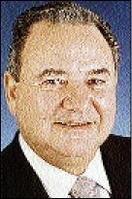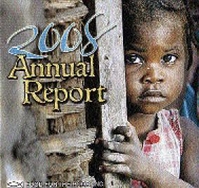Food For the Poor defies economic downturn
Published: Friday | May 22, 2009

Robin Mahfood, president and CEO of Food for the Poor.
Food For The Poor Inc, which is ranked among the largest charities worldwide, pulled in close to US$500 million (J$44.5 billion) more in the value of cash and kind donations last year.
Income reached US$1.5 billion, but the charity poured out just as much into its projects.
So even with its belt tightened as the economic downturn forced FFTP to cut expenses across its
18 international locations the charity ended the year US$2.1 million in deficit.
That's even with the reduction of expenses, as a ratio of inflows, to a 27-year low of 2.26 per cent.
Will not cut programmes
The outcome was, however, an improvement on 2007 - the deficit for that year was US$2.4 million on income of US$1.03 billion.
Defiantly, however, Robin Mahfood, president and CEO of the Florida-based chairuty, says he will not cut programmes in Jamaica.
Instead, the organisation chose to cut the organisation's numbers, slashing 14 jobs in January in the face of what it said was a decline in the number and value of donations here.
Across the FFTP network, donated goods amounted to US$940 million and cash pledges rose above US$89 million - the two largest income streams for the charity, contributing 93.6 per cent and 6.1 per cent of revenue respectively.
Other income accounted for 0.3 per cent, Food For The Poor said.
The charity's just released 2008 annual report indicates that in its drive to send an ever growing proportion of its aid funds and goods
directly to the cause for which it was established in 1982, spending US$34.2 million or 2.26 per cent of income on housekeeping expenses.
The year before, recurrent spending was nominally lower at US$33.3 million, but higher proportionate to income at 3.2 per cent.
"I am very pleased that we have been able to raise our efficiency ratio to more than 97 per cent," said Mahfood, speaking through a publicist, from his Coconut Creek, Florida office.
"There is still room for us to become even more efficient and that is a challenge that I know we are up to."
Fund distribution
Of the 97.7 per cent of donated receipts that went directly to its programme areas last year, FFTP spent US$1 billion on health care, US$220 million on education, US$184 million on its basic needs initiative and US$39 million on community development.
Operating costs were split between fundraising, US$25.2 million, and US$9 million for management.
Distributions in 2008 represented 4,637 trailer loads of food, building materials, schools furniture, medical supplies, seeds and agricultural tools and other supplies - 297 more than in 2007.
In 2007 Jamaica topped the receiving countries by value with US$207.46 million worth of aid, but was overtaken last year by Guatemala, which received US$273.9 million worth of supplies against the US$270.5 million distributed in Jamaica.
Haiti received aid of US$223.8 million, Nicaragua US$180.8 million and Honduras US$173.5 million.
Food For the Poor is looking to increase its support to Jamaica in the years ahead, its president has said.
"Going forward, we hope to increase aid to the island in 2009 by building new schools and new housing units, constructing more sanitation stations, increasing skills training and providing greater
amounts of food and medical supplies. Wherever the need is greatest, we stand ready to serve," Mahfood said.
Angel Aloma, the entity's executive director, also speaking through the charity's publicist, said so far this year, FFTP has shipped more than 250 containers of aid to Jamaica, valued at more than US$33 million.
Will not lose sight of responsibility
However, the organisation says it will not lose sight of its responsibility to the 16 other countries in which it operates.
"Last year, Food For The Poor, increased overall aid to the poor throughout the Caribbean, Latin America, and the US by 33 per cent," said Aloma.
FFTP built 2,300 houses in Jamaica last year, but still has a 12,000 waiting list. A total of 8,417 houses were built in 2008 across the 17 Caribbean and Latin American countries in which FFP operates.
The charity quantifies its assets at US$32 million, down from US$35.8 million last year.
It remains the largest international relief and development agency operating in the United States.
In the latest ranking of the 200 largest US charities, Forbes magazine gave Food For The Poor an
efficiency ratio of 98 per cent, well above the industry average of 90 per cent.
business@gleanerjm.com

















